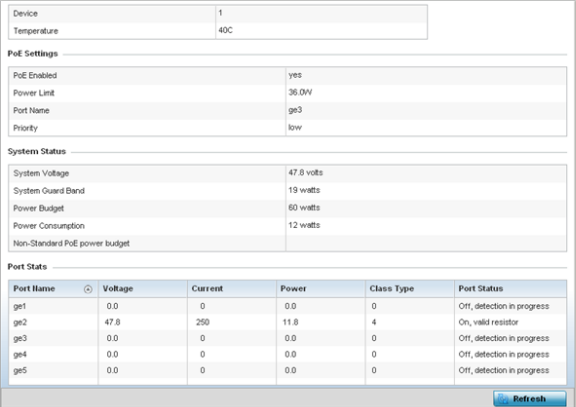Power Status
PoE is supported on WiNG model wireless controller. PoE allows users to monitor port power consumption and configure power usage limits and priorities for each GE port.
To view power status statistics:
- Select the Statistics menu from the Web UI.
- Expand the RF Domain node.
- Select a Wireless Controller.
- Select Power Status from the
left-hand side of the UI.The screen displays.
 This screen provides the following information for supported controllers:
This screen provides the following information for supported controllers:Device Displays the administrator assigned device name for the listed controller or service platform. Temperature Displays the internal system temperature for the controller or service platform. Power Limit Displays the total watts available for Power over Ethernet support. The value should be between 0 - 40 watts. Port Name Displays the GE port name on the controller. Priority Displays the power priority for the listed port as either Critical, High or Low. This is the priority assigned to this port versus the power requirements of the other ports. System Voltage Displays the total current system voltage. System Guard Band Displays the amount of voltage allocated to a System Guard Band. A System Guard Band is an amount of voltage allocated to prevent power loss or cycling on connected PoE devices when the power draw goes above the PoE Power Budget. Power Budget Displays the total amount of voltage allocated for use in Power over Ethernet. Power Consumption Displays the current amount of power being consumed by PoE devices managed by the controller or service platform. Non-Standard PoE power budget Displays the amount of voltage allocated to non 802.3af or 802.3at PoE devices. Port Name Displays the GE port name for each PoE capable port. Voltage Displays the voltage in use by each PoE capable port. Current Displays the amount of current in milliwatts being used by each PoE capable port. Power Displays whether or not each PoE capable port is providing power for potential requesting devices. Class Type Displays the PoE class type including 802.3af, 802.3at and non-standard PoE types. Port Status Displays the status of each PoE capable port on the controller. It will display either Enabled or Disabled. - Select Refresh to update the statistics counters to their latest value.

